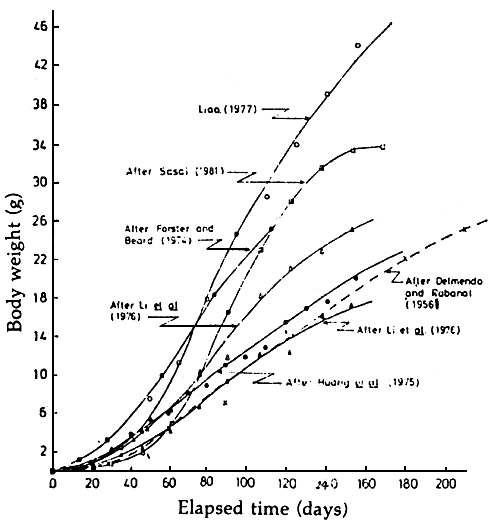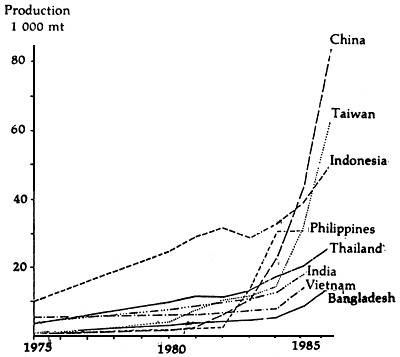by Medina N. Delmendo2
There are seven major shrimp species of interest in the Indo-Pacific region, namely:
| Species | English/vernacular names |
| Penaeus monodon | Giant tiger shrimp (sugpo) |
| Penaeus semisulcatus | Green tiger shrimp (bulik) |
| Penaeus japonicus | Kuruma shrimp (bulik) |
| Penaeus merguiensis | Banana or white shrimp (hipon puti) |
| Penaeus indicus | Indian white shrimp (hipon puti) |
| Penaeus orientalis | Fleshy shrimp |
| Metapenaeus spp. | Greasyback shrimp (suahe) |
Of these species, Penaeus monodon is the most widely cultivated species due to its fairly fast growth rate under various pond management systems (Figure 1); it tolerates wider salinity level fluctuation of environment and lends itself to domestication; its foreign market is well established. The expansion of shrimp farming in Southeast Asia is triggered by the increased inter-national market demand and the break-through made on seed production and intensive shrimp culture.

Figure 1. Growth curves of grass prawn, Penaeus monodon
(Source: Liao, 1986)
Of the cultured marine shrimp species, Penaeus monodon accounts for 40.9 percent; P. merguiensis and P. indicus, 23.3 percent; P. orientalis, 17.1 percent; P. japonicus, 1.2 percent; other penaeids, 3.6 percent; and Metapenaeus sp., 9.7 percent. Prawns account for 2.9 percent and swamp crab and Portunus sp. constitute 1.3 percent of all the crustaceans framed in the Indo-Pacific region (Csavas, 1988).
The world aquaculture production of crustaceans during 1975–1985 increased from 29 700 mt to 265 700 mt. The share of Asia increased from 22 700 tons to 198 500 tons which is equivalent to over . 70 percent of the world total production (Table 1).
By country, the People's Republic of China has the highest production; this is followed by Taiwan, Indonesia, Philippines, Thailand, India, Vietnam and Bangladesh in the order of production (Figure 2).
The farming of shrimps used to be secondary to milkfish until in 1968 Taiwan revolutionized its technology of production through artificial spawning. With this technological breakthrough, shrimp farming no longer depended on wild-caught fry; hatchery reared seeds became available which enabled shrimp farmers to intensify production. The technique of growing shrimps from juvenile stage to marketable size has been an extensive practice and farmers do not seem to have any problem raising them. However, the lack of seeds had been the bottleneck all along which hampered intensification of production.

Figure 2. Cultured crustacean production in Asia
Source: Csavas, 1988
Table 1. Global production of cultured crustaceans
Unit: 1 000 metric tons
| Continent | 1975 | 1980 | 1985 | Annual growth (%/year) |
| Africa | - | - | 0.1 | - |
| America, North | 5.8 | 8.3 | 33.8 | 48.3 |
| America, South | 1.2 | 6.0 | 32.9 | 264.1 |
| Asia | 22.7 | 60.7 | 198.5 | 77.4 |
| Europe | 0.0 | 0.0 | 0.4 | 423.0 |
| Oceania | - | - | 0.0 | - |
| World total | 29.7 | 75.0 | 265.7 | 80.6 |
Percent share of Asia (%) | 76.6 | 80.9 | 74.7 | - |
Souce: Csavas (1988)
Now, the lack of seedlings has been met by hatchery operations. As of May 1989 there were 325 units of hatcheries in the Philippines; in Taiwan, there were 1 800 hatcheries in 1986 which produced 10 billion shrimp larvae. No information is available in the Philippines as to how much shrimp fry were produced in the same period as this is a guarded secret of private operators. Suffice it to say that there has been a rapid expansion of shrimp farming in this country despite multifarious technical problems and losses incurred by some newcomers in the hatchery business. The successful ones would keep their secrets more zealously while the losers would probably try some more or completely get out of the business. There are some large hatchery facilities that are not working well and lying idle.
For the benefit of newcomers in shrimp farming and the traditional practitioners, this compilation is an attempt to put together essential technical information relevant to shrimp farming activities including hatchery development and techniques which could further improve present practices and perhaps help modify existing management techniques both on seeds production and grow-out of shrimps. The technical problems which require solution should be given appropriate attention by government administrators and research institutions.